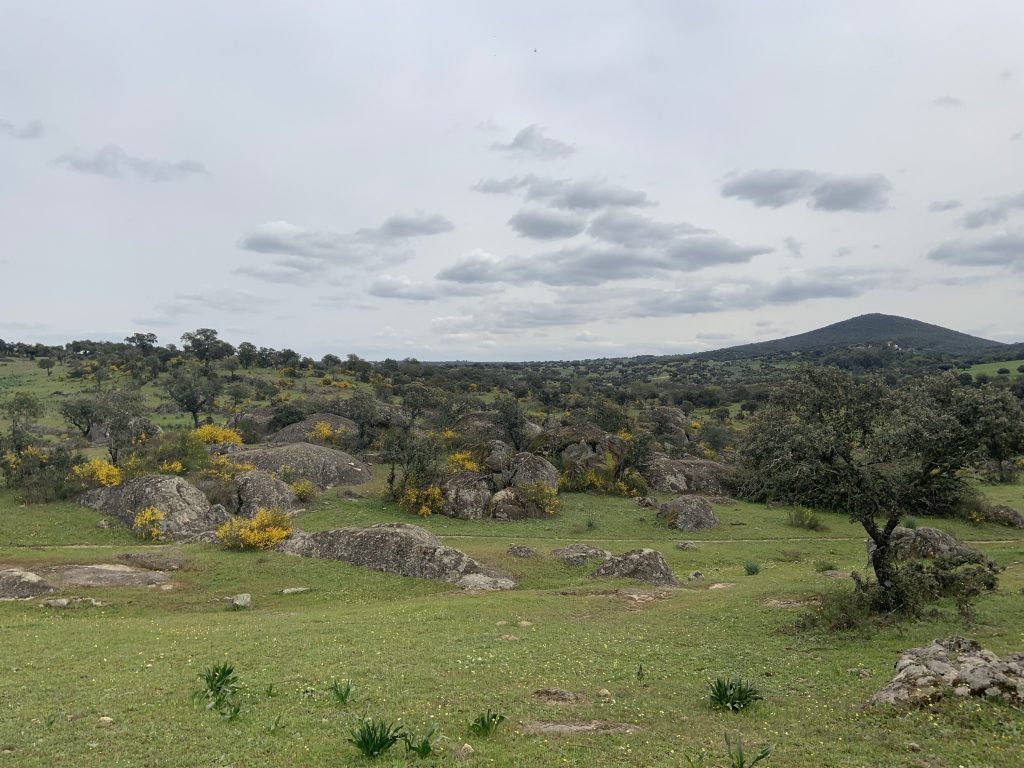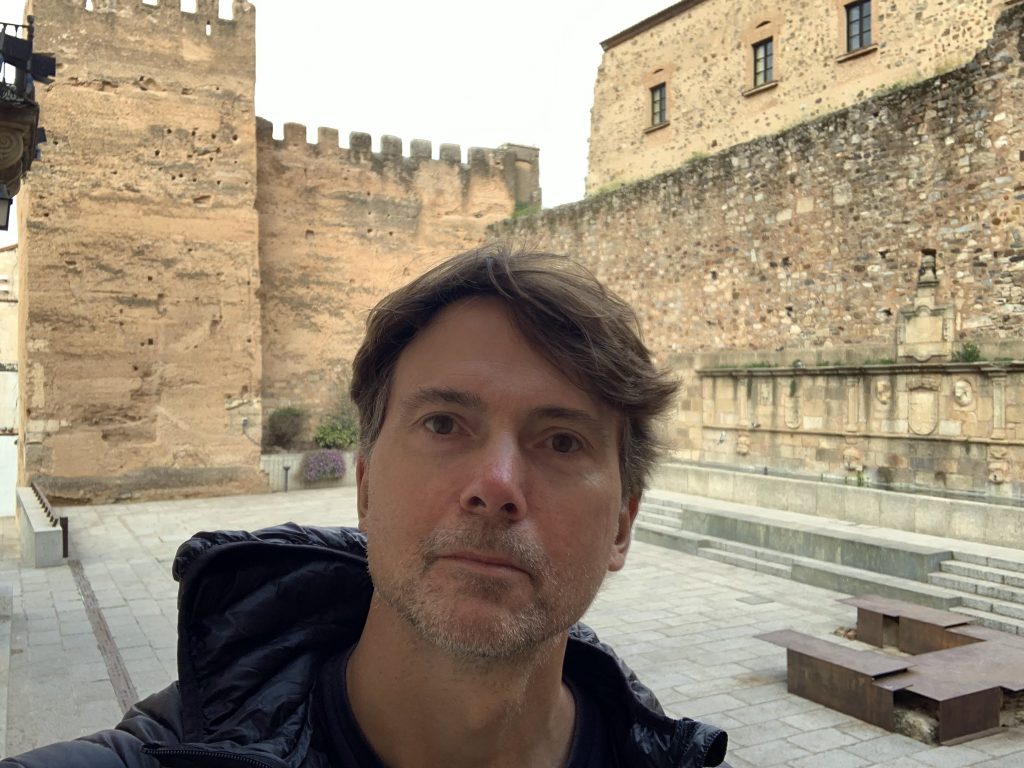During my many years of traveling and living in Spain, I always dreamed of someday walking the Camino de Santiago from the Pyrenees to Santiago de Compostela, otherwise known as the Camino Francés because of its starting point in France. This is the most popular pilgrimage route across the north of Spain into Galicia where pilgrims from across Europe have trekked since the Middle Ages. It is believed that when St. James died, his body was carried by ship to Santiago from the Holy Land and for well over one thousand years Santiago has been one of the most important religious sites for those of the Christian faith.
What is not commonly known by Americans, is that there are, in fact, many Caminos from different parts of Spain that lead to Santiago such as the Camino Portugués which begins in Lisbon and stretches north through Portugal up to Santiago and also the Vía de la Plata which is the Camino that begins in Sevilla and weaves its way through Extremadura and Castilla/León and finally into Galicia. Although most of my adult life, I thought I would walk the Camino Francés, because I am living in Sevilla, the logical launch point for my journey was right here at the Cathedral of Sevilla.
In preparation for my pilgrimage, I began walking at least five miles every day starting back in December. Honestly, I have never been much of a hiker and my body type of “tall and lanky” I soon found, is not the ideal body mechanic for a journeyman on foot! Leading up to my day of departure, I was already suffering from heel pain, ankle pain and blisters from all of my obsessive city training. Even with all of my diligent exercise, I was not prepared for the heavy dose of walking that I would have to tackle on the Camino. I have been a gym rat all my adult life and like to think that I am in good shape for my age but, as I soon learned, there are very different modes of “being in shape” and I was about to endure a whipping!
Before leaving Sevilla in early March, I dropped by the association of friends of the Camino in Sevilla to have a chat with one of the members about what I should expect as a pilgrim on the trail. The older gentleman was very helpful and encouraging and mentioned that I had picked the best time of year to walk the Vía de la Plata because during the brutally hot summer months it is virtually impossible to make the walk through Andalusia up into Extremadura. Over the years, pilgrims have suffered from heat exhaustion and have had to be saved in rural parts of the Camino because there are long stretches in the south where there are no pueblos or water. Another aspect of the Vía de la Plata he pointed out was that it is also the longest Camino in Spain at 1050 kilometers, more or less. That is about 200 km longer than the Camino Francés. Upon hearing that fact, I began to do calculations in my head and he stopped me and chuckled and said that I should budget 40 days to make the walk to Santiago. I said, “Wow, that’s 25 km a day!” and he just smiled and said, “We all walk the Camino at our own pace.” A steely truth for certain.
The very last item I bought at the association was my Credencial. Your Credencial is the official booklet of the Camino where you accumulate stamps from the different towns where you pass. Upon arriving in Santiago, you must show your Credencial to one of the authorities who will either accept or reject your Camino as being legitimate. Furthermore, the Credencial is useful during the pilgrimage because if you show it to restaurants and hostels, you will receive food and rooms for a lower, pilgrim rate.

Speaking of hostels, in reality, most of the time when arriving at your destination for the day, pilgrims almost always board at an albergue. Albergues are municipal hostels specifically made for pilgrims of the Camino. The rate at these albergues was 15 euros for the night and generally speaking, I was very satisfied with the accommodations at each albergue. You would always share large or small rooms filled with bunk beds, very much like a summer camp experience in a cabin. With the exception of one albergue just south of Alcuéscar at a truck stop where there was only lukewarm, brown water, I had a hot shower every evening during my stays at albergues. The slightly warm and brown water ended up being a good laugh for all of my compatriots that evening over dinner at Hostal Los Olivos. I will say the albergue made up for the water by serving us a great meal for $10.00. You take the good with the bad, just like sleeping in a large room with ten adults. Some snore and some don’t!
Leaving Sevilla on March 8 with my backpack tight against my shoulders, I headed out of the city, following the trademark, yellow arrows that can be found painted on stop signs, street curbs, coin meters and any number of fixed stanchions. Although I had my iphone with me which made navigating the Camino much easier, often I kept it in my pocket and would just follow the yellow arrows, often repeating in my head, “Follow the Yellow Brick Road”. I snapped a photo of the Via de La Plata plaque at the Cathedral of Sevilla and for the next eighteen days, trudged along urban sidewalks, grassy fields, sandy footpaths, rocky slopes and muddy trails until I paused my pilgrimage at the halfway point in Salamanca, the ancient university city whose old quarter is mesmerizing.
During those eighteen days, I was honored to have met a great group of men and women along the Camino, many of whom were veterans of the Camino de Santiago and were beginning their sixth or seventh Camino. Early into my walk, I spoke very little and listened closely, following the sage advice of a 60 year old man from Cataluña named Francisco who gave me the best tricks for healing my sore feet and blisters which really changed the rest of my pilgrimage for the better. The geographic diversity among the pilgrims was surprising as well. 1. Three women retirees from Belgium who had started their walk in Almería which added another 400 km to their Camino! Their plan was to walk for 60 days. 2. 73 year old Peter from Sheffield, UK who was starting his sixth Camino and with whom I enjoyed sharing tea in the afternoons. 3. Two seventy year olds who had met on the Camino years ago, one from Italy and another from Argentina. I walked half a day with them and really had a blast talking about music. Jorge had seen Pink Floyd in the 70’s in Barcelona and I was all ears about that experience! He was a hippie artist who found himself in Formentera in the 70’s and launched a career working with silver. 4. Santiago, another man from Cataluña who had undergone some serious brain surgery. His Camino was very spiritual for him and I really respected his personal quest to overcome his physical limitations. These colorful individuals and many others helped to make the Camino a wonderful human experience outside of the grueling physical experience that it so obviously is. 90% of the time, it seems all pilgrims walk alone because, as the expert in the Association told me, we all walk at our own pace. I think, also, an addendum to his saying that I would add is, we all walk with our own thoughts and the Camino is as much an internal reflection and meditation as it is a gritty and sweaty endeavor of flesh and bone.

My time on the Camino was cut short because I had to get back to Sevilla before Semana Santa, which is Easter Holy Week, to meet up with some clients whom I will be touring through Sevilla. Honestly, I am glad that I was fortunate to get a few clients during Semana Santa because my body had really taken a beating during the 18 days on the Camino. I lost eight pounds and was experiencing plantar fasciitis in both heels of my feet. Although the 1200 mg of Ibuprofen I started taking to relieve the pain was helping, I wasn’t exactly excited about taking that much Ibuprofen each day. As I discovered, many of the pilgrims who walk the Camino do it in stages and I was just fine with knocking out the first, southern half during the cool month of March and plan to get back to Salamanca at the end of May/early June to walk the second half to Santiago when the weather heats up in the north of Spain. My last day in Salamanca it was 45 degrees!
In this blog post, I chose not to go into depth about every little town where I stayed nor did I discuss the changes in terrain over the 500 km that I walked. It is just way too much information to cover in one posting. I will say that I was excited to finally pass through Mérida and see its wonderful Roman ruins, most specifically its Roman theater. Walking through El Parque del Norte, the national park in northern Andalusia was also a nature highlight for me. Finally, I had never been to Cáceres in Extremadura and I was able to spend one night there. I plan to go back to Cáceres because its old quarter is one of the prettiest in Spain and not often visited.
For those of you who are friends with me on Facebook, I will be posting many pictures and videos from each day of my walk.
